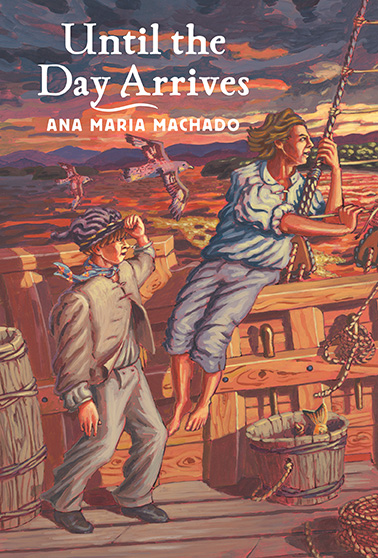
Until the Day Arrives
فرمت کتاب
ebook
تاریخ انتشار
2014
Lexile Score
850
Reading Level
4-5
نویسنده
Jane Springerناشر
Groundwood Books Ltdشابک
9781554984572
کتاب های مرتبط
- اطلاعات
- نقد و بررسی
- دیدگاه کاربران
نقد و بررسی

October 13, 2014
Machado’s (From Another World) finely sketched characters and settings propel this historical novel, set in the early 17th century, which follows two orphaned siblings from Lisbon to colonial Brazil. After losing their family to the plague, the siblings end up in Lisbon, where older brother Bento gets imprisoned following a bar fight, forcing 11-year-old Manu to find him. Once they are reunited, Bento’s arrest leads to his exile in Brazil, and the siblings embark on a harrowing journey. A deeply affecting parallel story line follows the capture of an entire African village, during which 11-year-old Odjiji and his family are forced onto a slave ship. Bento and Manu’s arrival in Brazil is particularly powerful, as they realize that the beautiful, bustling docks are home to the ugliness of a brutal slave market. Interconnected relationships between the siblings and slaves highlight the cruelty and unfairness of the system, especially as Bento falls in love with a slave and Manu becomes dear friends with one. This brief but action-packed novel offers memorable insights into slavery, colonial life, and the promise of freedom. Ages 10–13.

October 1, 2014
In the early 17th century, two hauntingly plague-orphaned Portuguese siblings flee their village for Lisbon, only to encounter more vicissitudes before reaching a safer haven in Brazil. Manu and Bento exhibit strong loyalty to each other, and they adhere faithfully to their Roman Catholic upbringing. For most of the story, 11-year-old Manu, a girl, poses as a boy for safety's sake, a device that both furthers the plot and may help readers believe the siblings' feminist, anti-racist and anti-slavery values that, however sympathetic, seem more in sync with 21st-century progressive values than those of their own time. The third-person narrative is mostly told from Manu's point of view, but it also follows captured Africans-in grim, realistic detail-to their eventual relationships with Manu and Bento. When Bento falls in love with the African slave Rosa, and Manu befriends both the African slave Didi and the indigenous boy Caiubi, the siblings learn about quilombos-settlements of runaway slaves-and put their abolitionist values into action. In Springer's translation, Machado's story is sometimes hindered by stilted, patronizing or sentimental passages. Didactic interludes provide contextual information about such complex subjects as Portuguese/Brazilian history and the trans-Atlantic slave trade; these are augmented by a helpful editorial note and glossary. Despite awkward moments, the tale offers vivid descriptions, an intriguing plot and a setting not often seen in North American literature for children. (Historical fiction. 10-13)
COPYRIGHT(2014) Kirkus Reviews, ALL RIGHTS RESERVED.

December 1, 2014
Gr 5-8-In a brief but sweeping 17th-century tale, acclaimed Brazilian children's author Machado intertwines compelling stories of two exiled Portuguese orphans, an enslaved African family, and an aboriginal boy who meet in Brazil. Survivors of the plague, siblings Bento and Manu live on the streets of Lisbon. After Bento is arrested in a tavern brawl and sentenced to exile, distraught Manu is aided by a wealthy couple who arrange safe passage and haven for both boys in Brazil. Far away, on the African savanna, Odjidi and his family are captured and forced onto a slave ship bound for Brazil. Jesuit priests help Bento find work as a carpenter and place Manu, who reveals her true girl identity, in the home of a kind widow. At school, Manu befriends a native boy, Caiubi, and these two get to know a young slave, Didi, who dreams of finding his family and escaping to a deep forest quilombo or village for runaway slaves. Meanwhile Bento falls in love with Rosa, a young slave girl, and is determined to marry her. Realizing the desperate plight of their enslaved friends, Bento, Manu, and Caiubi hatch a plan to help them find family and freedom. Concise, vivid descriptions of chaotic Lisbon streets, colorful markets in Brazil, and the expansive African savanna create a rich cultural backdrop. References to the Inquisition and the plague, Portuguese and Catholic colonization of Brazil, importation of slaves, and struggles of indigenous people provide historic context. Characters are intentional but appealing. Action is steady, and lives intersect. The dilemmas and passion of a broad cast of characters will engage and inform middle-grade readers.-Gerry Larson, formerly at Durham School of the Arts, NC
Copyright 2014 School Library Journal, LLC Used with permission.

November 15, 2014
Grades 5-8 Portuguese siblings Bento and Manu are orphaned and exiled during the Inquisition. Set in seventeenth-century Brazil, this survival tale explores persecution, religion, and the brutality of the African slave trade. After orphaned Portuguese siblings Bento, 13, and Manu, 11, are exiled to Brazil, they try to build a better life for themselves as they rely on their generosity and wits. Together with aboriginal friend Caiubi, Bento and Manu (who is actually Manuela but is pretending to be a boy for greater safety) conspire to reunite their enslaved friend Odjidi with his familyand then help them all escape to a freedom settlement deep in the forest. Quickly paced chapters tell the story of each character until the plot draws them together, and their plans begin to hatch. Readers will admire the patience of and preparation taken by the siblings to ensure that their strategies succeed. A gripping adventure from master storyteller Machado, a Hans Christian Andersen Award winner.(Reprinted with permission of Booklist, copyright 2014, American Library Association.)

























دیدگاه کاربران